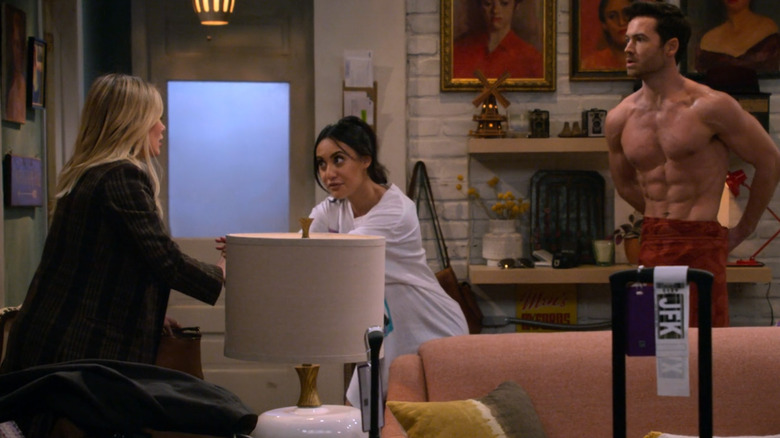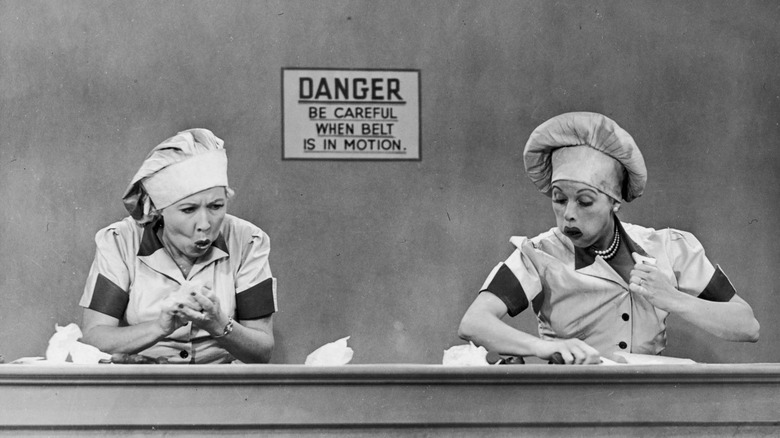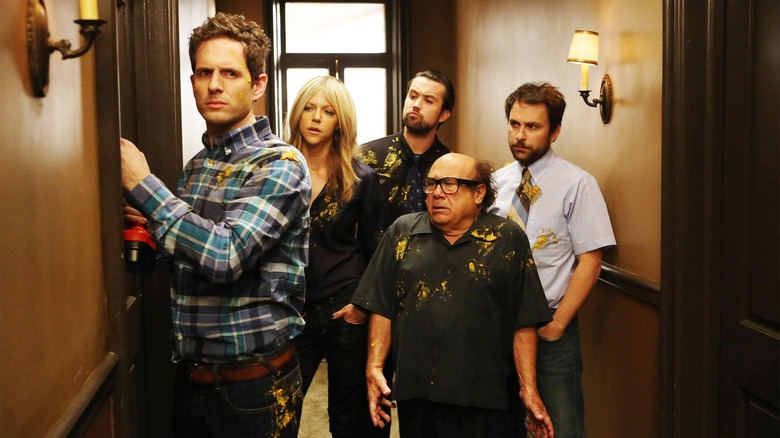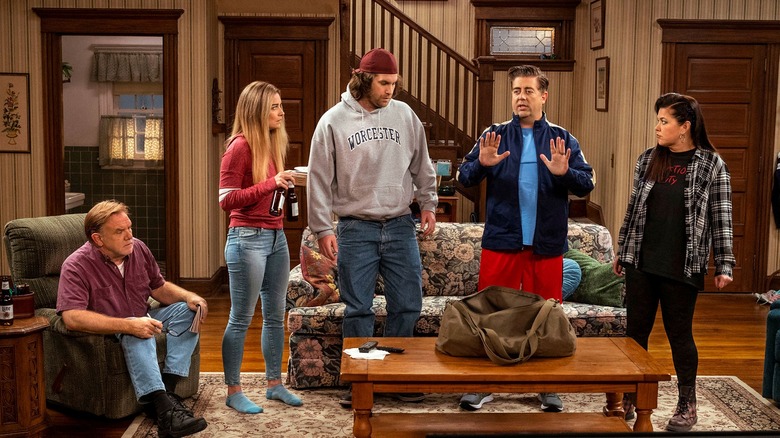How I Met Your Father Brings Up One Big Question - Why Are Sitcoms Still Using Laugh Tracks?
Canned laughter has never exactly been beloved. Multi-camera situation comedies (sitcoms) have used laugh tracks for decades, the recorded laughter of past generations punctuating jokes on everything from "Seinfeld" to "The Big Bang Theory." The technique has always had its critics, and in recent years has seen a decline as single-camera comedies and cringe humor rose in popularity. One series that was often derided for its use of the laugh track was "How I Met Your Mother," and its sequel series on Hulu, "How I Met Your Father," is no different. The same strange laughs we've heard for years are dropped in at opportune moments, both giving the audience permission to laugh and telling them when it's time to do so. It's almost strange to watch, after years of growing used to shows doing away with faux giggles in favor of awkward silences or comedic beats.
So why do some shows still use a laugh track? Where did it come from, why did it fall out of favor, and why are some sitcoms still clinging to this vestige of vintage television?
Live Studio Audiences and the Laff Box
In the early heyday of sitcoms, filming in front of a live studio audience was the norm. The giggles and guffaws on shows like "I Love Lucy" were the actual audience responding to the silliness on stage before them. Some shows even included bloopers with the studio audience at the end of episodes, most notably the 1990s series "The Fresh Prince of Bel Air" and "Home Improvement." Sometimes, however, the audience didn't react quite the way producers wanted them to, and they needed a way to make sure the folks at home felt like they were laughing with someone. In 1950, CBS sound engineer Charley Douglas developed a machine full of taped laugh tracks that he could use to dub over the actual audience reaction. The machine, dubbed the Laff Box, made its debut on "The Hank McCune Show", and was created with laughs recorded from the silent variety acts on "The Red Skelton Show."
While many shows continued to film with multiple cameras in front of a live audience, much like a stage play, they started using the Laff Box to tweak the amount or timing of laughter in editing. Even at the time, the use of the laugh track was derided by creatives, with TV production chief Bob Unger telling Billboard magazine in 1955 that he hated using canned laughter, but thought TV audiences expected a studio audience and it was a necessary evil.
Regardless of whether they shot using a live audience or not, sitcoms began using laugh tracks with some consistency. By the 1980s and 1990s, sitcoms were pretty much expected to have laugh tracks. The recorded laughter from Douglas' box was and is still the primary laugh track resource. That means, as "Lullaby" author Chuck Palahniuk eerily pointed out (via The Mirror), that most of the people we hear laughing are dead.
Comedy's Television Evolution
In the early 2000s, TV comedy shifted. Single-camera network shows like "Malcolm in the Middle," "Scrubs," and "The Office" moved away from laugh tracks as well, using music stings or other techniques to make up for their absence. Cable comedies like "It's Always Sunny in Philadelphia" and "Workaholics" pushed the boundaries of good taste and relied on hard cuts and awkward silences for laughter cues instead of a laugh track. These shows didn't film in front of a studio audience, even if some still use a multi-camera format, like "Its Always Sunny." Audiences started getting used to comedy without an assumed studio audience, and the use of laugh tracks began to decline. For shows without a live studio audience, there just didn't seem to be a point anymore. Some shows, like "The Big Bang Theory," still shot in front of a live audience, so canned laughter was sometimes needed to tweak the real thing.
One series that wasn't filmed in front of a studio audience but had a laugh track anyway was "How I Met Your Mother," which ran for nine seasons, starting in 2005. The boxed laughs are intended to create a feeling of community, like you're laughing along with a bunch of other viewers. There's something more digestible about a show with a laugh track, especially for older viewers. There's a warm nostalgia in shows with laugh tracks, even when the moments feel forced. While some viewers might find it to be an imposition or a rude interruption, others might find comfort in not being forced to laugh alone. Like comedian Bo Burnham sings in his song "Goodbye": "Does anybody want to joke when no one's laughing in the background?"
For some, sitcoms are a way to battle loneliness. Why else would so many sitcoms be about groups of friends? The laugh tracks, in a way, can help the viewer feel like they're laughing with someone instead of cackling on their couch by their lonesome.
Different Styles for Different Shows
Where does that leave us now? Some shows still use laugh tracks without a studio audience, as "How I Met Your Father" currently demonstrates. Is it occasionally grating? Sure, but it also hearkens back to a different era, and in doing so pays homage to the sitcoms of the past. Other shows, like the AMC dark comedy "Kevin Can F*** Himself," use the laugh track subversively, punctuating moments of the main character's humiliation with harsh ha-ha's.
Canned laughter still has a place in television, though certainly not to the extent that it once did. For shows with one foot in the past and one in the future, like "How I Met Your Father," a laugh track makes sense. I don't think we'll ever see the technique go away entirely. But maybe they should update those audio recordings, at least, so we're not listening to a bunch of giggling ghosts.
New episodes of "How I Met Your Father" debut Tuesdays on Hulu.



